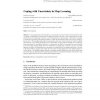89 search results - page 13 / 18 » A Critique of the Valiant Model |
SIGECOM
2006
ACM
14 years 3 months ago
2006
ACM
Braess’s Paradox is the counterintuitive but well-known fact that removing edges from a network with “selfish routing” can decrease the latency incurred by traffic in an eq...
FOCS
1993
IEEE
14 years 1 months ago
1993
IEEE
Learnability in Valiant’s PAC learning model has been shown to be strongly related to the existence of uniform laws of large numbers. These laws define a distribution-free conver...
IJCAI
1989
13 years 11 months ago
1989
In many applications in mobile robotics, it is important for a robot to explore its environment in order to construct a representation of space useful for guiding movement. We refe...
SIAMCOMP
1998
13 years 9 months ago
1998
This paper introduces the queue-read, queue-write (qrqw) parallel random access machine (pram) model, which permits concurrent reading and writing to shared memory locations, but ...
SIGCSE
2010
ACM
14 years 3 months ago
2010
ACM
This paper presents an experience in designing, implementing, and evaluating a studio-based learning model for CS2. Adapted from architecture and art education, as well as from co...

